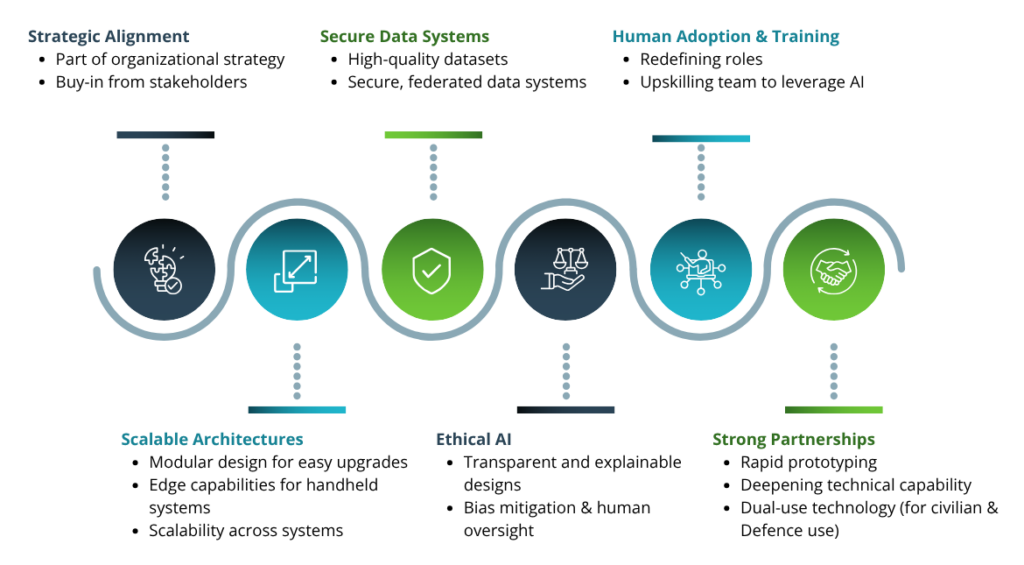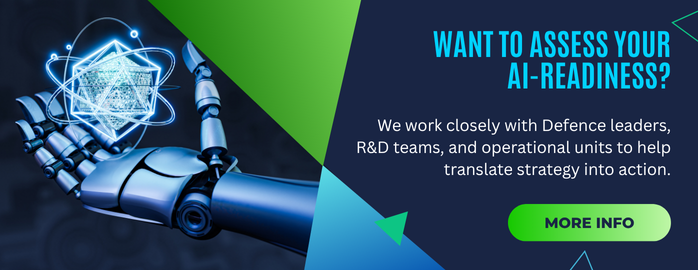We live in a rapidly shifting technological and geopolitical landscape, and putting our thoughts into the future of Defence has become imperative in today’s day and age. The path forward is driven by intelligent systems that can sense, decide, and act at machine speed. Artificial Intelligence is no longer a distant ambition but a present-day necessity. But while the potential of AI in Defence sector is widely acknowledged, the question that continues to challenge militaries and Defence organizations globally is: What does it truly take to be AI-ready?
As a technology partner deeply engaged with Defence modernization, we offer a view from the ground: what we see, what we’ve learned, and how we believe that Defence organizations can practically achieve AI readiness in the mission-critical world of Defence and research labs.
AI is shaping the next generation of warfare-defined by speed, autonomy, and hyper-connectivity. From cognitive radios that self-optimize in real-time to intelligent threat detection, autonomous systems, and AI-optimized 5G/NTN communications, AI is becoming the digital spine of modern militaries.
In India, this transformation is already underway. The Indian Defence market was valued at USD 17.3 billion in 2024, and analysts project it will reach USD 29.8 billion by 2033, growing at a CAGR of 5.6%. This growth reflects the country’s commitment to tech adoption.
India has deployed over 140 AI-enabled sensor systems along its borders with Pakistan and China. These help with real-time surveillance and target identification at critical points like the Line of Control.
This transformation, however, doesn’t happen overnight. The integration of AI is a journey, not a switch. It calls for foundational readiness—not just in technology but in strategy, people, data, ethics, and collaboration.
Here’s our interpretation based on our on-ground experience and continuing interactions with stakeholders in the Defence ecosystem:

For AI to be truly effective, it must fit into the overall goals expected of military ai, not just be used in separate projects. This means:
India’s government has recognized this imperative, allocating ₹2,000 crore (~USD 270 million) for the IndiaAI mission in 2025-26 alone, as part of a broader ₹10,371.92 crore (~USD 1.4 billion) five-year plan to develop indigenous AI capabilities, including military applications.
AI needs good data to work well—just like a soldier needs reliable intel. For Defence organizations, this means:
The Indian Army has deployed over 140 AI applications for situational awareness, intelligence extraction, and operational efficiency, demonstrating the scale and importance of robust data systems in the Indian context.
AI won’t perform well if the data is siloed, poorly labeled, or missing context. Also, AI models need to keep learning from fresh data, which is only possible with automated data pipelines and scalable infrastructure.
In short, without the right data setup, even the smartest AI will fall short.
Being AI-ready is not only about having smart algorithms, it’s also about how well people adapt AI and are ready to work with it. AI in Defence operations need to adapt so that AI helps with decision-making but doesn’t replace human judgment. This means:
India’s Military College of Telecommunication Engineering is at the forefront of this shift, deploying AI-driven applications that support both operational and training needs, and ensuring that human-AI collaboration is at the heart of modern Defence technology.
Human-AI teams work best when the AI is easy to understand, trustworthy, and enhances human capabilities, not when it’s a “black box” that’s hard to figure out.
For AI in Defence sector to succeed, its software needs to be:
A showcase for a next-gen, indigenous weapons systems is the BRAHMOS-NG missile variant, produced in the BrahMos Aerospace plant in Lucknow in 2025. It demonstrates the integration of AI and flexible, scalable software architectures in next-generation weapon systems.
Using closed software systems can lead to gaps in use of artificial intelligence in military. Open systems bring interoperability, while containerization streamlines the deployment tailored for specific situations and requirements.
Using AI for Defence purposes comes along with ethical concerns, on how autonomous weapons are utilized or how surveillance happens. Being ready for ethical AI means:
Another goal for India is to achieve “technological sovereignty”, which means lesser dependence on foreign hardware, and developing its own capabilities. India’s investment in indigenous AI chips and GPUs is an important step in responsible AI adoption. Steps towards ensuring ethics in AI include strong governance frameworks and audit trails.
Traditional Defence procurement processes can be time consuming and make it hard to keep up with fast-moving AI innovation. To be AI-ready, Defence organizations need to:
India’s Defence sector is leveraging the ‘Make in India’ initiative, partnering with startups and academia to speed up the creation of dual-use AI tech. In fact, some of the most successful ventures in AI have emerged from these sorts of collaborations.
While using AI in Defence has immense potential but putting it into action comes with significant real-world challenges. Here are some of the most common ones:
Many Defence systems still run on old hardware and software that weren’t designed to support AI. Due to the absence of streamlined processes, integration of legacy systems with AI tools, sensors and communication devices becomes laborious and complicated.
Defence, which works with some of the most sensitive data, needs to uphold the strongest security posture. Hence this data cannot be processed or stored on any public platform.
This also necessitates the AI systems to run within secure and local environments. These air-gapped systems require special tools, security checks and custom workflows to ensure secure operations.
People working in Defence may be cautious about trusting AI, especially when decisions impact safety or mission success. Building trust takes time and requires making AI systems more transparent, easy to use, and proven in real-world conditions.
AI isn’t just a future concept—it’s already being used in Defence today. Let’s look at three key areas where AI is making a real impact, and what that tells us about being AI-ready.
In today’s battlefields, radio communication can be disrupted due to crowding or jamming. AI-powered cognitive radios help solve this by:
India’s deployment of AI-powered cognitive radios and sensor networks along the border has significantly improved real-time threat detection and communication reliability in high-risk zones.
Defence forces that are AI-ready are adding these smart radios to their communication systems, allowing them to maintain reliable contact even in tough conditions.
Modern warfare is not just about weapons, it’s about having better information. AI supports this by:
Organisations that are well-prepared treat AI as a core part of their strategy—not just a tool.
AI is also improving Defence communication networks like tactical 5G and NTN (Non-Terrestrial Networks), by:
AI-powered drones and UAVs are revolutionizing border surveillance by providing real-time intelligence and reducing personnel risk in high-tension zones across India.
AI-ready Defence teams treat their networks as intelligent systems that actively support mission success, rather than just tools for sending data.
From our experience working closely with Defence organisations, one thing is clear: AI readiness isn’t something you can just buy, it’s something you build over time.
When we partner with Defence teams, we don’t start by pushing technology. We start by understanding the mission and the real problems on the ground. Our approach includes:
Whether it’s creating smart communication systems, combining data from various sensors, or running AI directly on drones or aircraft—we focus on delivering reliable, mission-driven software.
We believe a good software partner isn’t just about writing code. It’s about bringing the right mindset: focused on Defence challenges, speed, and impact.

Defence organisations around the world are starting to rethink their capabilities using AI. But just having the right technology isn’t enough to win battles. What really matters is readiness—being strategically, operationally, and culturally prepared for AI.
The journey to AI readiness is long, starting from integrating systems to reaching innovative solutions. Defence organisations are at an important moment in this journey. The ones who lead clearly, work quickly with partners, and build with purpose will define the future of warfare.
In this process, software partners are not just suppliers; they are key contributors to strengthening national security.